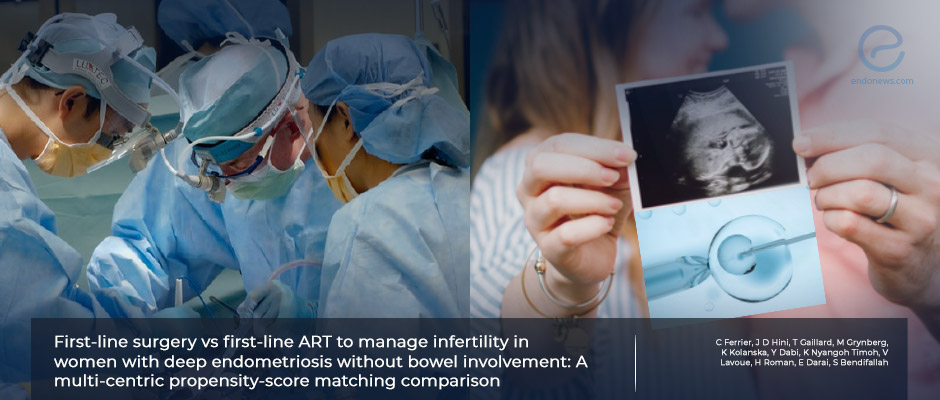First-line surgery or first-line ART: A real challenge both for the clinicians and infertile women having DIE without colorectal involvement
Apr 14, 2023
Although a patient-centered decision is recommended, the use of first-line surgery for patients with "DIE-associated infertility without colorectal involvement" is an advisable approach in terms of pregnancy outcomes.
Key Points
Highlights:
- If there are no other infertility factors influencing the pregnancy, surgery provides a significant improvement in terms of pregnancy rate and live birth rate in the patients having DIE without colorectal involvement.
Importance:
- First-line surgery is more meaningful in terms of pregnancy rate and live birth rate for patients having DIE without colorectal involvement.
What’s done here?
- This retrospective analysis was conducted to compare the pregnancy results of infertile patients with "deep infiltrating endometriosis (DIE) without colorectal involvement" who underwent first-line surgery or first-line assisted reproductive technologies (ART) considering in vitro fertilization-intracytoplasmic sperm injection (IVF-ICSI).
- All benefits and risks of each strategy were explained to the patients by the surgeon and the ART specialist and they chose their management approach.
- Physical examination and imaging methods including transvaginal sonography and magnetic resonance imaging were used to diagnose endometriosis.
- All endometriotic lesions by laparoscopy were removed by the high-volume surgeons while various controlled ovarian stimulation protocols were applied by the experienced ART specialists.
- The primary outcomes were pregnancy rates (PR) and live birth rates (LBR) whereas the secondary outcomes were cumulative pregnancy rate (CPR) and cumulative live birth rate (CLBR).
Key results:
- A total of 284 eligible patients were included and divided into two groups after matching: 92 in the first-line ART group and 92 in the first-line surgery.
- The pregnancy rate, clinical pregnancy rate, and live birth rate were found to be higher significantly in the first-line surgery group.
- Non-ART pregnancies were not observed in the first-line ART group whereas 17 non-ART pregnancies occurred in the first-line surgery group.
- When the pregnancy rate and live birth rate were additionally assessed in the subgroup of women with good fertility prognosis, and with at least one negative fertility factor, both rates were significantly higher in the first-line surgery group.
- A significant correlation was detected between the probability of pregnancy and age, associated endometrioma, being managed by first-line surgery based on logistic regression analysis.
- Additionally, there was a significant association between the probability of live birth and age, prior delivery, and associated endometrioma, being managed by first-line surgery.
Strengths and Limitations:
- This is the first study to assess fertility outcomes in women having DIE without colorectal involvement by minimizing confounding factors such as age, BMI, duration of infertility, male infertility, serum AMH level, and the endometriosis phenotype.
- Retrospective design with non-randomized data, no evaluation of endometrioma size, no stratification regarding the impact of pain intensity, and no surgical confirmation of endometrioma in patients in the first-line ART group are the limitations of the study.
Lay Summary
Deep infiltrating endometriosis (DIE) is defined as the presence of endometriotic lesions over 5 mm in depth under the peritoneal surface. These women suffer from chronic pelvic pain, dysmenorrhea, dyspareunia, chronic pelvic pain, bloody or painful bowel movements, and infertility. There is a dilemma about whether the treatment of infertility should be primarily surgery or ART in DIE-associated infertility.
Ferrier et al., from France, published a review titled “First-line surgery vs first-line ART to manage infertility in women with deep endometriosis without bowel involvement: A multi-centric propensity-score matching comparison” in the journal named European Journal of Obstetrics & Gynecology and Reproductive Biology. The authors aimed to compare the pregnancy results of infertile patients having DIE without colorectal involvement who underwent first-line surgery or first-line ART treatments.
Pregnancy rates and live birth rates were assessed as the primary outcomes while the secondary outcomes were cumulative pregnancy rate (CPR) and cumulative live birth rate (CLBR). The authors grouped the participants using propensity-score matching. The demographic and clinical characteristics did not differ between the groups. Pregnancy rate, CPR and LBR were found to be higher significantly in the first-line surgery group. Pregnancy rate and LBR were also significantly higher in the first-line surgery group in the subgroup analysis of women with good fertility prognosis and with at least one negative fertility factor. The age of the patient, the presence of endometrioma, and being managed by first-line surgery had a significant association with the probability of pregnancy.
“First-line surgery offers higher pregnancy and live-birth rates than first-line ART in patients with DIE without colorectal involvement.” the authors added.
Research Source: https://pubmed.ncbi.nlm.nih.gov/36516605/
endometriosis infertility surgery assisted-reproductive techniques pregnancy rate live birth rate confounding factors

